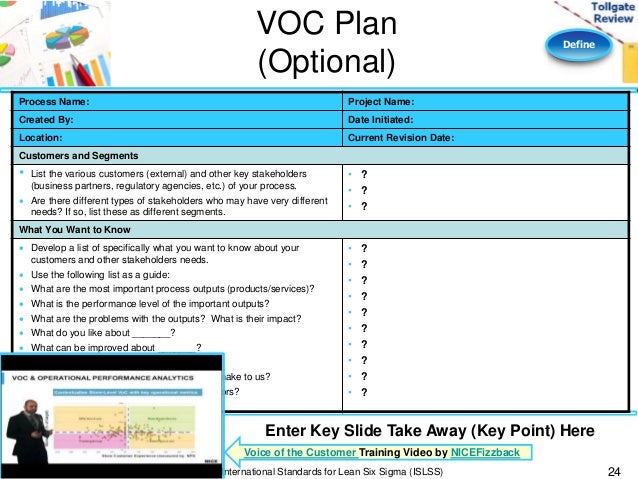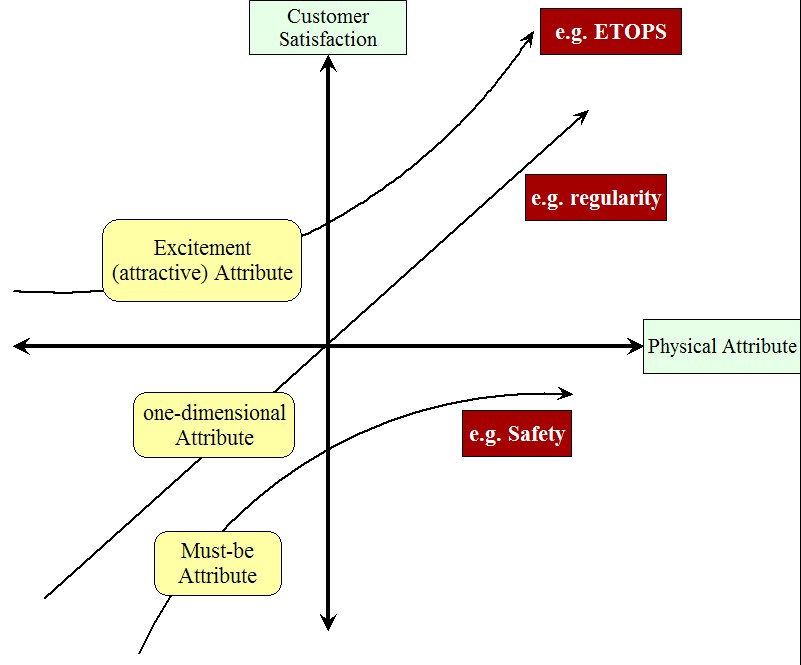Six Sigma Kano Template


CTQ Definition Voice of the Customer (VQC) Affinity Diagrams Tapping Into the VOC Understanding Customer Wants Prioritizing CTQ The Kano Model is also referred to as Kano Analysis.Developing Operational Definitions Applying Operational Definitions to CTQs Rath& Strong suggested a process for collecting VOC data Net Promoter Score (NPS) CTQ Definition The product/service characteristics that are important to the customer from the customer’s point of view. Voice of the Customer (VQC) An understanding of the needs of the customer is critical to thesurvival of most companies. The pace of change in today’s economy mandates that a company cannot rely ontheir past knowledge of the customer. A detailed plan to gather and collect customer needs and customer perceptions can be described as listening to the voice of the customer (VOC).
Six Sigma tools. Lean Six Sigma templates for quality improvement. Download free trial Excel templates for Lean Six Sigma process improvement.
This enables the organization to:. Make decisions on products and services. Identify product features and specifications. Focus on improvement plans.
Develop baseline metrics on customer satisfaction. Identify customer satisfaction drivers Rath& Strong suggested a process for collecting VOC data: 1.
Identify customers and their needs 2. Collect and analyze reactive data (customer complaints, service calls, warranty claims), consider proactive (interviews, focus groups, surveys) approaches 3.
Convert collected data into customer needs 4. Sort out the most important attributes that the customer wants, that is, information critical to quality characteristics. Obtain specifications from the critical-to-quality characteristics Affinity Diagrams Affinity diagrams can be good tools to take complex customer information and to organize it into logical categories. Compaq Armada 110 Drivers Xp Download. Potential creative solutions can also be displayed and organized using this technique. Because of its format, the affinity diagram is helpful in the problem definition stage of Six Sigma.
Tapping Into the VOC Interview Learn about a specific customer’s point of view on service issues, product/service attributes, and performance indicators/measures. Supports development of hypotheses about customer needs. Focus Group Organize information from the collective point of view of a group of customers that represent a segment. Helps clarify and define customer needs. Survey Measure the needs or the importance and performance of a product, service or attribute across an entire segment or group of segments.
Furnishes quantitative data Customer Complaint Data Collect and classify customer feedback about product performance, features and attributes –classify by type across product lines. Furnishes qualitative and quantitative data Understanding Customer Wants Voice of Customer(What They Said) Key Issues Requirement Prioritizing CTQ 1. Must Be CTQs are a critical priority for improvement. PerformanceCTQs will improve competitiveness of your product or service.
Delighters may not be the focal point for current process improvement, but may someday be a “Must Be.” The Kano Model is also referred to as Kano Analysis. It is used to analyze customer requirements. NoriakiKanois a Japanese engineer and consultant, whose work is being usedby a growing number of Japanese and American companies. The model is based on 3 categories of customer needs: 1. Dissatisfiers, (basic requirements, or “must be’s”): The customer expects these basic requirements as part of the total package.
If the basic requirements are not present, the customer will be unhappy. Satisfiers, (variable requirements, or “more is better”):When the requirements of the customer are met, the more it is met, the better. The tourist taking a Caribbean cruise expects a week of entertainment and food at a reasonable price. The more the tourist is taken care of on the cruise, the better it is.
In fact, the cabin help, dining room help, or any staff on the ship are out to make your travel experience, a great one. Delighters, (latent requirements): These are features or services that go beyond the expectations of the customer. For the tennis fan who. Purchases a ticket to the U.S. Open, the basic requirements would at least be to see some players in competition, not get sunburnt, and to see some thrilling matches. Imagine meeting these expectations, and then being able to have lunch or dinner with some players as part of the experience.
This would be a delighter. Competition in today’s environment raises the basic expectations of all customers. The standards of a happy customer continue to rise.
What was once considered a delighter, may in time turn into a basic satisfier. The organization has to be aware of the customer’s changing needs and move to improve their own performance. Improvement projects can often be selected from among the satisfier and delighter categories. Most companies in a competitive environment would not be around long enough to tackle a basic requirement issue. CTQ One technique that is useful in the Six Sigma problem definition stage is the construction of a critical to quality tree. This tool focuses on the key metrics of customer satisfaction. A CTQ tree will translate the initial customer requirements to numerical or quantified requirements for the product or service.
These are the detailed critical requirements for the organization to satisfy. These can be regarded as key results, or the “Ys” of the process.
The development of a CTQ tree would go from the general requirement to the specific, or going from “hard to measure” to “easy to measure.” Generally it will require 2-3 levels to transgress from: need to drivers to CTQs. The creation of the CTQ tree involve these steps: 1. Identify the customer. Example: a customer at a fast food store. Identify the customer’s need.
Example: a customer is hungry and orders a meal. Identify the first set of basic requirements of the customer.Example: Several measures of effectiveness or efficiency to meet the need. Perhaps the measures are speed of delivery, price, and good taste. Progress further with more levels as needed. Determine if additional details are needed for breakdown of the measures.
Validate the requirements with the customer. The CTQ tree should be reviewed with the customer to be sure that the requirements and CTQs will help the customer. Developing Operational Definitions •Operational definitions are descriptions written in a way that ensures consistent interpretation by different people•The operational definition method of description will be used throughout the DMAIC process Applying Operational Definitions to CTQs •Accurately describe the Critical-To-Quality characteristic(s)•Specifically state what is considered meeting customer expectation(s) (Defect*-free) New content: Net Promoter Score ( NPS): This can be used to calculate customer loyalty.
In your survey, you will ask only one question from your customer ” How likely is it that you would recommend our company/product/service to a friend or colleague? Lego Batman 2 Full Movie Download. The scoring for this answer is most often based on a 0 to 10 scale” Those who respond with a score of 9 -10 are called Promoters, and are considered likely to exhibit value-creating behaviors, such as buying more, remaining customers for longer, and making more positive referrals to other potential customers. Those who respond with a score of 0 to 6 are labeled Detractors, and they are believed to be less likely to exhibit the value-creating behaviors. Responses of 7 and 8 are labeled Passives, and their behavior falls in the middle of Promoters and Detractors. The Net Promoter Score is calculated by subtracting the percentage of customers who are Detractors from the percentage of customers who are Promoters.
For purposes of calculating a Net Promoter Score, Passives count towards the total number of respondents, but do not directly affect the overall net score.% of Promoter –% of Detractors = NPS NPS can be as low as −100 (everybody is a detractor) or as high as +100 (everybody is a promoter). An NPS that is positive (i.e., higher than zero) is felt to be good, and an NPS of +50 is excellent.
Depending on your score, you can go in depth with root cause analysis why your NPS score is low or high. You can do root cause with above technique describe on this page as CTQ, VOC.